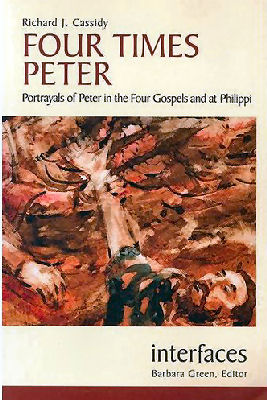
|
Posted April 19, 2007
Book: Four Times Peter: Portrayals of Peter in the Four Gospels and at Philippi Author: Richard J. Cassidy Liturgical Press. Collegeville, MN. 2007. Pp. 154 An Excerpt from the First Chapter:
Narrative criticism is not practiced in the same way by every interpreter, but fundamentally it can be understood to encompass three interrelated strategies of analysis. First, narrative criticism seeks to analyze the various elements that serve as building blocks for the overall story the author has narrated. Second, it undertakes to analyze the literary techniques the author employed as a means of presenting the narrative in a coherent and engaging way. Third, narrative criticism investigates the author’s assumptions about the readers for whom the story was originally intended. Finally, as a corollary which present-day readers of the story are themselves actually reading the story. An Excerpt from the Book: Summary of Matthew’s Portrayal of Peter In Part II of his Gospel Matthew portrays Jesus calling Peter first and underscores Peter’s prominence on the list of Jesus’ selected apostles by employing the modifier “first.” In various episodes Peter enjoys a privileged closeness with Jesus and is even accorded the privilege of walking on water. Along with others, Peter is subject to having “little faith.” Nevertheless, as Part II closes he reaches his zenith by confessing that Jesus is the Christ. Jesus’ response to Simon’s confession is to bestow on him the name “Peter.” a name linked with this disciple’s new role in serving as a rock foundation for Jesus’ church. At the beginning of Part III, Peter tries to dissuade Jesus from the path of suffering and death. In reply Jesus castigates him as “Satan” and calls him a “stumbling block.” Nevertheless, Jesus then restores Peter by inviting him to experience his transfiguration. Peter then continues to follow Jesus and, along with the other apostles, eventually receives the promise that he will serve as a judge over the twelve tribes of Israel. As Jesus’ Passion draws near, Peter proclaims his willingness to die with him. Yet he is unable to stay awake in Gethsemane and he egregiously denies Jesus three times in the high priest’s courtyard. Peter’s tears of repentance represent an initial step in his return to faithful discipleship, but full restoration does not occur until the risen Jesus gathers him and the rest of the eleven in Galilee. In a mountain setting Jesus majestically imparts to them a mandate for making disciples of all nations. Matthew, having previously emphasized Jesus’ multiple initiatives on behalf of Peter, does not mention him by name in these post-resurrection scenes. Table of Contents: 1. Aspects of Narrative Criticism and the Four Gospels 2. Peter in Mark’s Gospel 3. Peter in Luke’s Gospel 4. Peter in Matthew’s Gospel 5. Peter in John’s Gospel 6. The reception of the four gospels at Philippi List of Figures |
|
